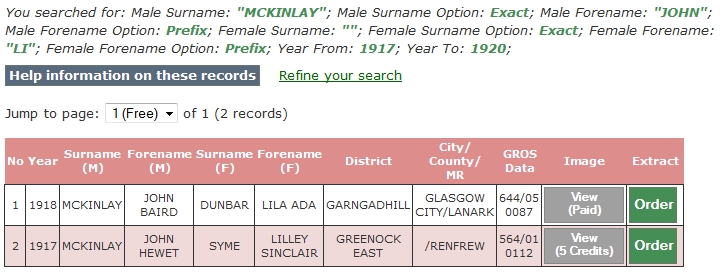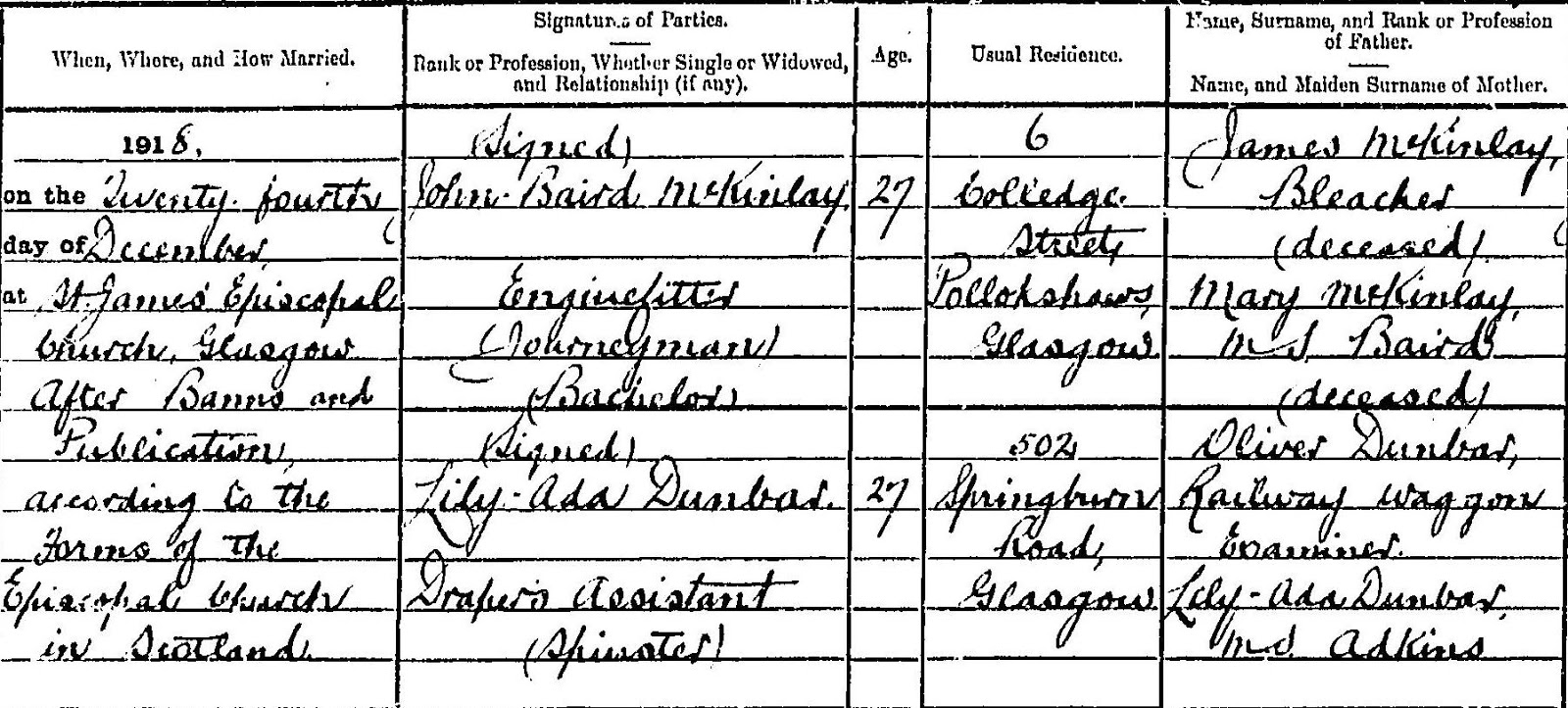Much like many of you I too have a family tree hosted on
Ancestry. I use that tree for cousin bait and also to let the computers at Ancestry do some of the easy research for me while I sleep. Many of those hints are for census records and after reviewing the documents I make an informed decision as to whether the person on the census page really does match who I am presently working on. With my world subscription (vital for my Canadian, USA, UK, Australian, and even some Irish research) I sometimes get some very strange possible matches to people in my tree. This is one of those cases.
In my tree I have a John McKinlay (my 1st cousin twice removed) born 4 Jul 1891 at 33 Maxwell Street in Pollokshaw, Scotland
1. He is the son of James McKinlay, a cloth bleacher foreman, and Mary Baird. I had found him in the 1901 census of Scotland living with his parents and siblings. The last record of him I could find was as the informant of his father's death in 1916. At that time John was residing at 6 College Street, Glasgow (same place his father's home). After that John disappeared.
In the waning days of 2014 a little hint appeared on John's page. This hint was for a record in the "World War II Draft Registration Cards, 1942" collection.
 |
| Ancestry.com, "U.S. World War II Draft Registration Cards, 1942," database on-line, Ancestry.com (http://www.ancestry.com/ : accessed 9 Mar 2015), entry for John Baird McKinlay, serial number U601, Draft Board 8, Elizabeth, Union County, New Jersey; citing Selective Service Registration Cards, World War II: Fourth Registration. Records of the Selective Service System, Record Group Number 147, National Archives and Records Administration. |
The birth date was right and that document recorded that he was born in Glasgow, Scotland. Also knowing that a mother's maiden surname may be used for a middle name I was tempted to added that record. Yet a name and a matching birth date didn't necessarily mean it was the same person. It did mention that a Mrs. Lily McKinlay living at the same address was a "
person who will always know your address". Could she be his wife? However, I had to put those questions to the side and deal with other branches of my tree first. Instead of getting distracted by this BSO
2 I created a To Do item and carried on with my research task I had initially started working on.
Today, while avoiding other activities, I decided to look into this To Do item
3.
Instead of linking that record to my existing John McKinlay I created a new person John
Baird McKinlay and connected that record to him. I also added a spouse with the first name of Lily. It was a guess that she was his wife but I needed to start somewhere
4.
Next I looked for John and Lily in the 1940 US Federal Census. From the registration card I knew that John and Lily lived at 867 Sheridan Avenue, Elizabeth, Union County, New Jersey, USA and there I found them. But I still don't really have any additional details on John. I do now know that Lily is his wife and she was born about 1892 in England.
 |
| 1940 U.S. census, Union County, New Jersey, population schedule, Elizabeth, enumeration district (ED) 23-90, sheet 4B, household 120, John McKinlay household; digital images, Ancestry.com (http://www.ancestry.com : accessed 9 Mar 2015); citing National Archives and Records Administration microfilm T627, roll 2400. |
Can I find them in the 1930 Federal Census of the USA? I didn't really even need to search since an Ancestry hint popped up for that census. But I still needed to read and analyze to make sure it was the correct census for John and Lily ... and it seemed to be the right entry.
![1930 U.S. census, Union County, New Jersey, population schedule, Elizabeh, enumeration district (ED) 66, sheet 23A, p. 35 [stamped], dwelling 387, family 574, John McKinlay household; digital images, Ancestry.com (http://www.ancestry.com/ : accessed 9 Mar 2015); citing National Archives and Records Administration microfilm T626, roll 1387; Original data: United States of America, Bureau of the Census. Fifteenth Census of the United States, 1930. Washington, D.C.: National Archives and Records Administration, 1930. T626, 2,667 rolls.](//2.bp.blogspot.com/-lXLBwKKvc9E/VP336B71bMI/AAAAAAAABnY/fp28RcZnpzs/s1600/Extract%2B-%2BMcKinlay%2B-%2B1930%2Bcensus%2Bof%2BElizabeth%2C%2BUnion%2BCounty%2C%2BNew%2BJersey%2C%2BUSA.jpg) |
| 1930 U.S. census, Union County, New Jersey, population schedule, Elizabeh, enumeration district (ED) 66, sheet 23A, p. 35 [stamped], dwelling 387, family 574, John McKinlay household; digital images, Ancestry.com (http://www.ancestry.com/ : accessed 9 Mar 2015); citing National Archives and Records Administration microfilm T626, roll 1387; Original data: United States of America, Bureau of the Census. Fifteenth Census of the United States, 1930. Washington, D.C.: National Archives and Records Administration, 1930. T626, 2,667 rolls. |
A few more facts appeared. The first is that they were both first married at the age of 27 years. This puts their marriage happening around 1919. As a starting point I'm assuming they were married to each other at that time and this is not a second marriage for both of them. The second is that they immigrated to the United States in 1920. So the odds are that they were married before they came to the USA.
With any luck they married in England (Lily's birth country) or Scotland (last place I found John). If England then I will need to order from the General Register Office for England and Wales for £9.25 and wait a few weeks to get a document. So off to
FreeBMD to search for a John McKinlay marrying a Lily.
 |
| FreeBMD.org search for marriages for John McKinlay between 1st quarter 1917 and 4th quarter 1920 |
Only three matches and when I looked at each one none had a Lily or anything close as a possible spouse. So it was off to
ScotlandsPeople to see if there was a marriage there for John McKinlay.
 |
| ScotlandsPeople.gov.uk search for statutory marriages for John McKinlay, wife's forename starting with "Li", with a year range between 1917 and 1920. |
Since it only found two possible matches it was definitely worth spending the 1 credit necessary to see the search results (note that the image above was taken after I viewed the index that is why it is free to view the page).
 |
| ScotlandsPeople.gov.uk search results for statutory marriages for
John McKinlay, wife's forename starting with "Li", with a year range
between 1917 and 1920. |
Usually I don't this lucky in my searches but there is
John Baird McKinlay marrying a
Lila Ada Dunbar in 1918. Since the Scottish statutory marriage registrations normally include the names of the parents of both parties it is definitely worth spending the 5 credits needed to view the marriage registration.
 |
| Lanarkshire, Scotland, Statutory Marriages 1855-2009, 1918 Marriages in the District of Garngadhill: 44, John Baird McKinlay-Lily Ada Dunbar, 1918; digital images, General Register Office for Scotland, ScotlandsPeople (http://www.scotlandspeople.gov.uk/ : accessed 9 Mar 2015). |
There is the John Baird McKinlay that I was hoping to find. Here he states that he is the son of the late James McKinlay, a bleacher, and the late Mary Baird. I actually have documents for James and Mary showing that they died before 24 Dec 1918 so that helps confirm this statement. Even the address for John matches (spelling to be ignored) the information on his father's death registration and John's last known address. This is a definitely a match to
my John McKinlay.
I now even have the full name of Lily ... it is Lily Ada Dunbar, the daughter of Oliver Dunbar and Lily Ada Adkins.
So the James Baird McKinlay initially flagged as a hint in the "World War II Draft Registration Cards, 1942" collection is the John McKinlay in my tree. Of course a new To Do item needs to be created: find their arrival in the New World.
Tip: Don't discount those hints that don't seem to fit at first. Form a hypotheses and work through the records. Sometimes you need to work backwards to find the answer.
1. Renfrewshire, Scotland, "Statutory Births 1855-2009," 1891 Births in the Parish of Eastwood, p. 102, John McKinlay; digital image, General Register Office for Scotland, ScotlandsPeople (http://www.scotlandspeople.gov.uk/: 25 Aug 2011).
2. BSO: Bright Shiny Object - the bane of most genealogy researchers since one can easily distract you from what you are presently working on.
3. 530 open items with 239 just for ordering records from the General Register Office of England and Wales. That is over £2200 or about $4200 CDN! Maybe I'll get them when I win the lottery.
4. Always be willing to throw away a theory if it doesn't pan out. However, make sure you record in your Research Log what you found and why it didn't work out.




